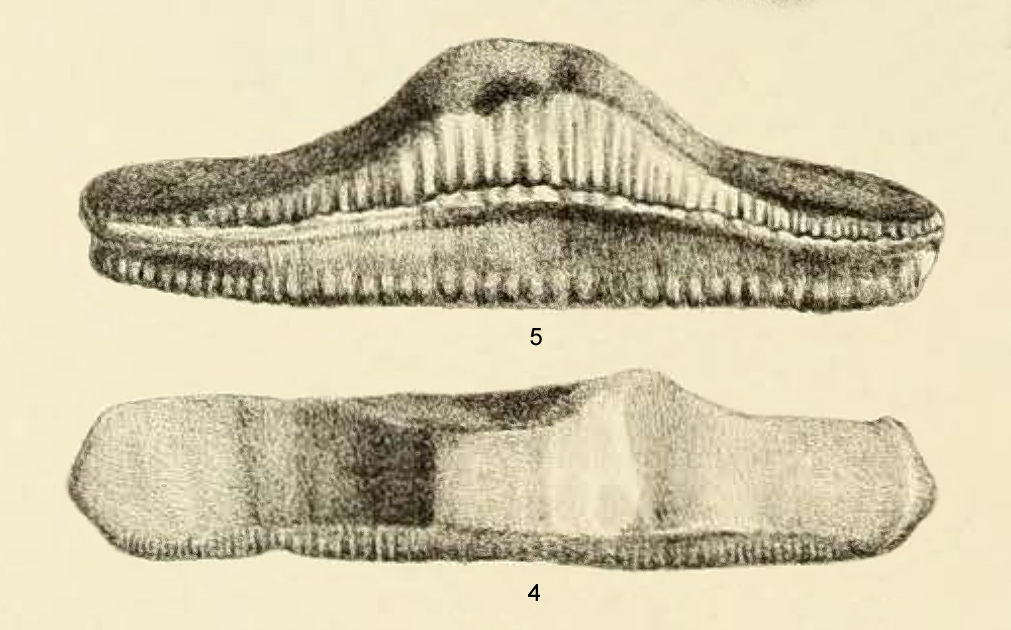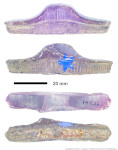Myliobates jugosus
Leidy, 1876
Classification: Elasmobranchii Myliobatiformes Myliobatidae
Reference of the original description
Remarks on fossils of the Ashley phosphate beds. Proceedings of the Academy of Natural Sciences of Philadelphia, 28, 86–87
Remarks on fossils of the Ashley phosphate beds. Proceedings of the Academy of Natural Sciences of Philadelphia, 28, 86–87
Image of the original description

Myliobates jugosus Leidy, 1876; image of the first description (pl. 31 figs 4-5), holotype, ?Manasquan Marls, Manasquan Formation, latest Paleocene to late Ypresian; Vincentown, New Jersey, USA; coll. Academy of Natural Sciences of Philadelphia, P 14536

Myliobates jugosus Leidy, 1876; image of the first description (pl. 31 figs 4-5), holotype, ?Manasquan Marls, Manasquan Formation, latest Paleocene to late Ypresian; Vincentown, New Jersey, USA; coll. Academy of Natural Sciences of Philadelphia, P 14536
Description:
Citation: Myliobates jugosus Leidy, 1876: In: Database of fossil elasmobranch teeth www.shark-references.com, World Wide Web electronic publication, Version 12/2025
Description
Original description after Leidy (1876) [1419] (only name), description in Leidy (1877) [1420]:
An isolated median tooth, represented in figures 4, 5, Pl. XXXI, probably indicates a species of eagle ray different from the former. The specimen is likewise from the marl of Vincenttown, Burlington Co., N. J., and was recenly presented to the Academy by Col. T.M. Bryan.
The tooth is transversely nearly straight, and the ends are angular and adapted to the articulation of small hexagonal teeth as in the species of Myliobates generally. The crown forms a thick median transversely convex prominence with the sides extended outwardly and thin. The prominence appears as an exaggeration of the median ridge of the dental plate of M. fastigiatus due to the more abrupt depression of the sides of the crown. The tooth at the median prominence is no thicker than in the smaller of the dental plates described under the name of M. fastigiatus, while it is considerably broader. The triturating surface is transversely convex on the median prominence and becomes nearly flat upon its reflected sides. The dull aspect of the triturating surface, and the comparatively thin condition of the sides of the crown probably indicate some reduction as the result of wearing. The anterior inclining surface of the crown and the projecting posterior surface indicate a somewhat imbricated arrangement of the median teeth. In the specimen the back of the eminence of the crown is unsymmetrical, apparently deformed. The base of the crown opposite the median eminence is concave, and this curvature at the sides is slightly deflected. The root is straight on its attaching surface.
The breadth of the tooth is nearly 2 1/2 inches; its median height 8 ¾ inches, and at the sides 4 lines. The width of the crown fore and aft is about 5 lines, and its thickness at the middle about the same, while at the sides it is but 1 ½ lines.
Original description after Leidy (1876) [1419] (only name), description in Leidy (1877) [1420]:
An isolated median tooth, represented in figures 4, 5, Pl. XXXI, probably indicates a species of eagle ray different from the former. The specimen is likewise from the marl of Vincenttown, Burlington Co., N. J., and was recenly presented to the Academy by Col. T.M. Bryan.
The tooth is transversely nearly straight, and the ends are angular and adapted to the articulation of small hexagonal teeth as in the species of Myliobates generally. The crown forms a thick median transversely convex prominence with the sides extended outwardly and thin. The prominence appears as an exaggeration of the median ridge of the dental plate of M. fastigiatus due to the more abrupt depression of the sides of the crown. The tooth at the median prominence is no thicker than in the smaller of the dental plates described under the name of M. fastigiatus, while it is considerably broader. The triturating surface is transversely convex on the median prominence and becomes nearly flat upon its reflected sides. The dull aspect of the triturating surface, and the comparatively thin condition of the sides of the crown probably indicate some reduction as the result of wearing. The anterior inclining surface of the crown and the projecting posterior surface indicate a somewhat imbricated arrangement of the median teeth. In the specimen the back of the eminence of the crown is unsymmetrical, apparently deformed. The base of the crown opposite the median eminence is concave, and this curvature at the sides is slightly deflected. The root is straight on its attaching surface.
The breadth of the tooth is nearly 2 1/2 inches; its median height 8 ¾ inches, and at the sides 4 lines. The width of the crown fore and aft is about 5 lines, and its thickness at the middle about the same, while at the sides it is but 1 ½ lines.
Remarks
shark-references Species-ID=10048;
valid after Leidy (1877) p. 240 [1420];
synonym of Leidybatis jugosus after Cappetta & Case (2016) p. 67 [24889]; Ebersole et al. (2019) p. 140 [27789];
shark-references Species-ID=10048;
valid after Leidy (1877) p. 240 [1420];
synonym of Leidybatis jugosus after Cappetta & Case (2016) p. 67 [24889]; Ebersole et al. (2019) p. 140 [27789];
References


Generic Assessment and Reallocation of Cenozoic Myliobatinae based on new information of tooth, tooth plate and caudal spine morphology of extant taxa. Palaeontos, 24, 1–66

Description of vertebrate remains, chiefly from the Phosphate Beds of South Carolina. Journal of the Academy of Natural Sciences of Philadelphia, 8(2), 209–261


Generic Assessment and Reallocation of Cenozoic Myliobatinae based on new information of tooth, tooth plate and caudal spine morphology of extant taxa. Palaeontos, 24, 1–66

Description of vertebrate remains, chiefly from the Phosphate Beds of South Carolina. Journal of the Academy of Natural Sciences of Philadelphia, 8(2), 209–261


















